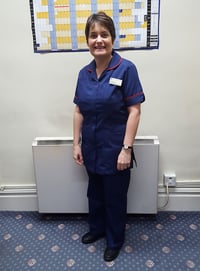Dementia with Lewy bodies is the third most frequent cause of dementia in older adults, and accounts for 15–35% of all dementias. Dementia with Lewy bodies is also the most common dementia syndrome associated with Parkinsonism. It is primarily a disease affecting the elderly population.
Men may be at higher risk of developing Lewy body dementia than women Dementia with Lewy bodies (DLB), also known as Lewy body dementia, is a common type of dementia estimated to affect more than 100,000 people in the UK. It's rare in people under 65.
 Zoe Ridewood - Specialist Nurse in Neurology
Zoe Ridewood - Specialist Nurse in Neurology
Dementia with Lewy bodies is similar to Alzheimer's disease in that it is caused by the degeneration and death of nerve cells in the brain. It takes its name from the abnormal collections of protein, known as Lewy bodies, which occur in the nerve cells of the brain.
Half or more of people with Lewy body disease also develop signs and symptoms of Parkinson's disease. People with Lewy body disease are very sensitive to some tranquillisers known as antipsychotic or neuroleptic drugs and their use should be avoided if at all possible.
Dementia with Lewy body affects:
- Concentration and attention
- Memory
- Language
- The ability to judge distances
- The ability to reason
- People with Lewy body disease can experience visual hallucinations
The cause of dementia with Lewy bodies is still unknown. A very few cases of familial (inherited) dementia with Lewy bodies have been reported, but this is rare.
DLB is diagnosed when someone has the symptoms of dementia either before or at the same time as developing Parkinson’s-like problems with movement (called motor symptoms). But in some cases of dementia with Lewy bodies, no motor symptoms may develop at all.
People with this form of dementia commonly experience visual hallucinations, which can be quite vivid. This can happen early on in the condition. They might also experience difficulty in judging distances and movements, which can cause them to fall over for no apparent reason. tends to develop slowly and get gradually worse over several years.
Providing the necessary support to families who have relatives living with Parkinson’s is key in trying to minimise their distress.
One such situation existed with a patient in our care and who was first diagnosed with Parkinson’s in 2007. Early years saw her being able to more or less carry out normal routine with the support of her partner, daughter and granddaughter. As the years passed, her social life became more and more difficult and in 2014 her partner passed away. Isolation became a major issue for this patient and at this time she then became prone to hallucinations that were distressing, not only for her, but also her family. Medication helped, but the episodes and frequent falls, resulted in fractures and broken bones and ultimately her daughter had to give up work to provide the necessary support that was required.
The support was 24 hours daily and divided between the family who helped with caring for her throughout the day and night. Eventually, the patient became isolated and lost close contact with her close family in Irelands. Her immediate family had less quality time together due to the need for 1:1 care and support 24/7.
We introduced the ‘RITA’ Technology as part of her care package which played an important part and provided a valuable tool for the carers, allowing them to record notes and journals around the day to day care. She became comforted and stimulated by the plethora of activities on the system and it created an opportunity to link with family members and also her GP for the necessary routine checks using the Skype features that were available. Having this technology to support the Care Plan put in place by the Specialist Nurse allowed the daughter to return back to work.
Notwithstanding the benefits already stated, other significant improvements have been, that she has had less falls and no hospital admissions due to falls. There have also been less occasions to contact me by the family since the technology has been introduced, where historically, I had been receiving SOS calls in-between clinic appointments. Overall, it appears she is much more engaged and has more social interaction and has helped remove any feeling of being isolated. The improvement in her demeanour has meant that she has recently been able to travel to Ireland to meet other close family members.
Obviously, we cannot cure LBD, but to be able to manage symptoms, behaviour and agitation is key to improving and enhancing the quality of care for patients and their families.
We have been supporting this patient and her family since 2011 and introduced one of the ‘RITA’ (Reminiscence Interactive Therapy Activity) systems as part of her package of care.
